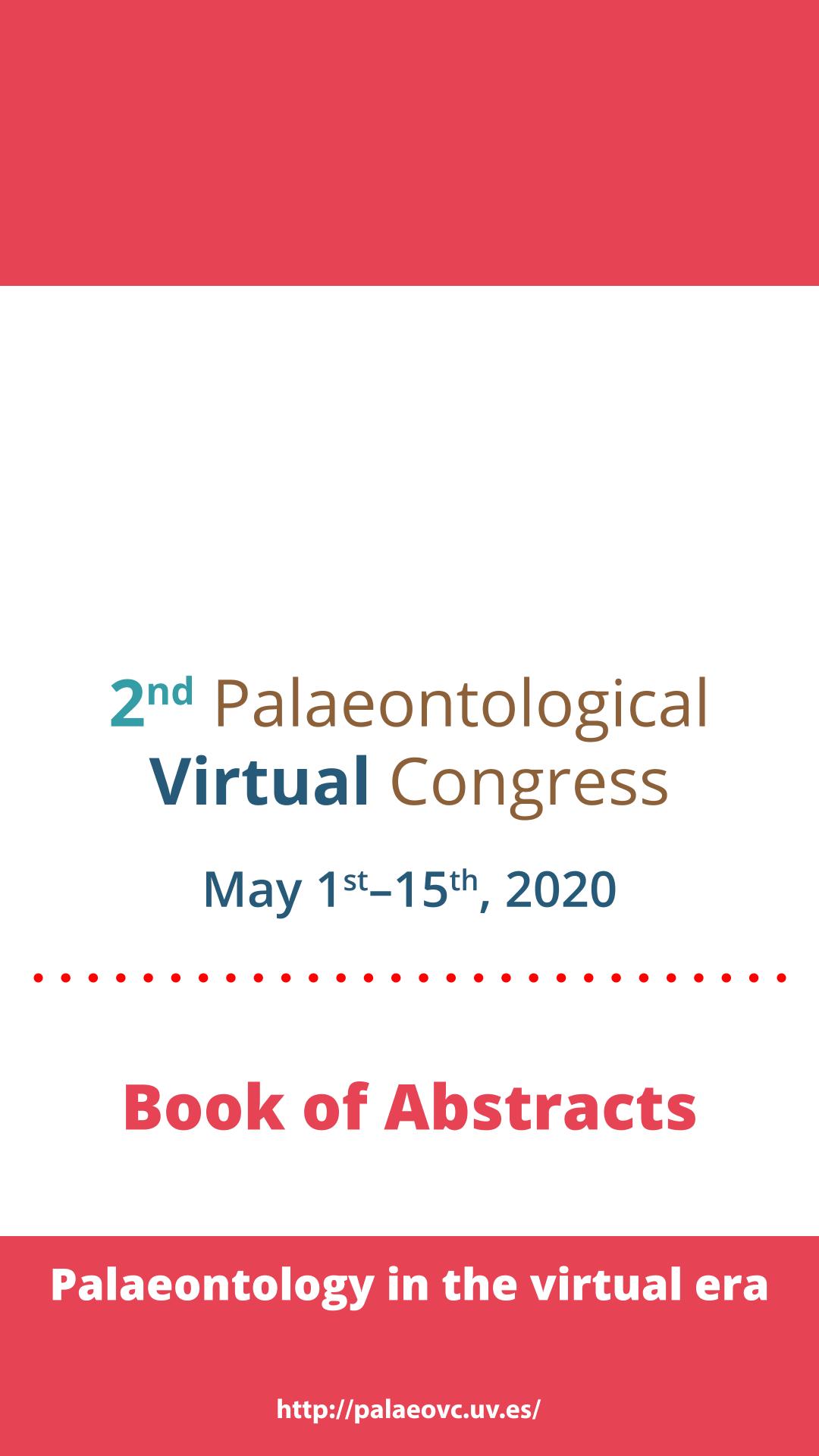Mostrar el registro sencillo del ítem
dc.contributor.author
Barasoain Goñi, Daniel

dc.contributor.author
Gonzalez Ruiz, Laureano Raul

dc.contributor.author
Tomassini, Rodrigo Leandro

dc.contributor.author
Zurita, Alfredo Eduardo

dc.contributor.author
Contreras, Victor Hugo

dc.contributor.other
Vlachos, Evangelos

dc.contributor.other
Manzanares, Esther
dc.contributor.other
Crespo, Vicente D.
dc.contributor.other
Martinez Perez, Carlos

dc.contributor.other
Ferrón, Humberto G.
dc.contributor.other
Herráiz, José Luis
dc.contributor.other
Gamonal González Iglesias, Arturo

dc.contributor.other
Arnal, Fernando Antonio M.
dc.contributor.other
Gascó, Francesc
dc.contributor.other
Citton, Paolo

dc.date.available
2022-11-01T12:19:38Z
dc.date.issued
2020
dc.identifier.citation
New analysis of Vetelia gandhii (Xenarthra, Cingulata) gives a novel hypothesis: was this armadillo a carnivorous tolypeutine?; 2nd Palaeontological Virtual Congress; España; 2020; 153-153
dc.identifier.isbn
978-84-09-20283-6
dc.identifier.uri
http://hdl.handle.net/11336/175772
dc.description.abstract
Vetelia is a genus of armadillos traditionally included within the subfamily Euphractinae (Chlamyphoridae), restricted to the Miocene of Argentina. It includes the species V. puncta (early and middle Miocene, Santacrucian, Friasian s.s., and Colloncuran), V. perforata (middle and late Miocene; Mayoan, Chasicoan, and Huayquerian), and V. gandhii (late Miocene; Chasicoan, Huayquerian), mostly known by isolated osteoderms. In this contribution, we analyze and describe both cranial and postcranial remains assigned to V. gandhii (PVSJ-289; PVSJ-154) from the late Miocene of Loma de Las Tapias Formation (Chasicoan) of San Juan Province, Argentina. The morphology of the osteoderms of the dorsal carapace suggest a higher affinity with the extant representatives of Tolypeutinae, including Priodontes, Cabassous, and Tolypeutes, rather than those of Euphractinae, based on: i) similar ornamentation pattern of both fixed and mobile osteoderms; ii) mobile and fixed osteoderms with external rugose surface; and iii) fixed osteoderms becoming subcircular towards the carapace lateral margins. Though molecular analyses already place the tolypeutines at ~26 Ma, and the most ancient record is represented by the Oligocene Kuntinaru; remains of these armadillos are extremely scarce in the fossil record; a circumstance that could be enhanced by a historic misidentification of Tolypeutinae diagnostic characters. Additionally, we carry out for the first time an anatomical analysis on Vetelia cranio-mandibular features, which is characterized by a dorsoventrally expanded rostrum, very robust horizontal ramus, powerful anterior dentition, presence of premaxillary teeth, massive chisel-shaped molariforms, and absence of anterior dental diastema, suggesting a trend or specialization towards carnivory.
dc.format
application/pdf
dc.language.iso
eng
dc.publisher
Palaeontological Virtual Congress
dc.rights
info:eu-repo/semantics/openAccess
dc.rights.uri
https://creativecommons.org/licenses/by-nc-sa/2.5/ar/
dc.subject
CINGULATA
dc.subject
TOLYPEUTINE
dc.subject
VETELIA
dc.subject
CENOZOIC
dc.subject.classification
Paleontología

dc.subject.classification
Ciencias de la Tierra y relacionadas con el Medio Ambiente

dc.subject.classification
CIENCIAS NATURALES Y EXACTAS

dc.title
New analysis of Vetelia gandhii (Xenarthra, Cingulata) gives a novel hypothesis: was this armadillo a carnivorous tolypeutine?
dc.type
info:eu-repo/semantics/publishedVersion
dc.type
info:eu-repo/semantics/conferenceObject
dc.type
info:ar-repo/semantics/documento de conferencia
dc.date.updated
2022-03-16T21:03:24Z
dc.journal.pagination
153-153
dc.journal.pais
España

dc.description.fil
Fil: Barasoain Goñi, Daniel. Consejo Nacional de Investigaciones Científicas y Técnicas. Centro Científico Tecnológico Conicet - Nordeste. Centro de Ecología Aplicada del Litoral. Universidad Nacional del Nordeste. Centro de Ecología Aplicada del Litoral; Argentina
dc.description.fil
Fil: Gonzalez Ruiz, Laureano Raul. Universidad Nacional de la Patagonia "San Juan Bosco". Facultad de Ciencias Naturales - Sede Esquel. Laboratorio de Investigaciones en Evolución y Biodiversidad; Argentina. Consejo Nacional de Investigaciones Científicas y Técnicas. Centro Científico Tecnológico Conicet - Patagonia Norte. Centro de Investigación Esquel de Montaña y Estepa Patagónica. Universidad Nacional de la Patagonia "San Juan Bosco". Centro de Investigación Esquel de Montaña y Estepa Patagónica; Argentina
dc.description.fil
Fil: Tomassini, Rodrigo Leandro. Consejo Nacional de Investigaciones Científicas y Técnicas. Centro Científico Tecnológico Conicet - Bahía Blanca. Instituto Geológico del Sur. Universidad Nacional del Sur. Departamento de Geología. Instituto Geológico del Sur; Argentina
dc.description.fil
Fil: Zurita, Alfredo Eduardo. Consejo Nacional de Investigaciones Científicas y Técnicas. Centro Científico Tecnológico Conicet - Nordeste. Centro de Ecología Aplicada del Litoral. Universidad Nacional del Nordeste. Centro de Ecología Aplicada del Litoral; Argentina
dc.description.fil
Fil: Contreras, Victor Hugo. Universidad Nacional de San Juan. Facultad de Ciencias Exactas, Físicas y Naturales. Instituto de Geología "Dr. Emiliano Aparicio"; Argentina
dc.relation.alternativeid
info:eu-repo/semantics/altIdentifier/url/http://palaeovc.org/index.php/downloads/
dc.conicet.rol
Autor

dc.conicet.rol
Autor

dc.conicet.rol
Autor

dc.conicet.rol
Autor

dc.conicet.rol
Autor

dc.coverage
Internacional
dc.type.subtype
Congreso
dc.description.nombreEvento
2nd Palaeontological Virtual Congress
dc.date.evento
2020-05-01
dc.description.paisEvento
España

dc.type.publicacion
Book
dc.description.institucionOrganizadora
Palaeontological Virtual Congress
dc.source.libro
2nd Palaeontological Virtual Congress: Book of Abstracts. Palaeontology in the virtual era
dc.date.eventoHasta
2020-05-15
dc.type
Congreso
Archivos asociados
